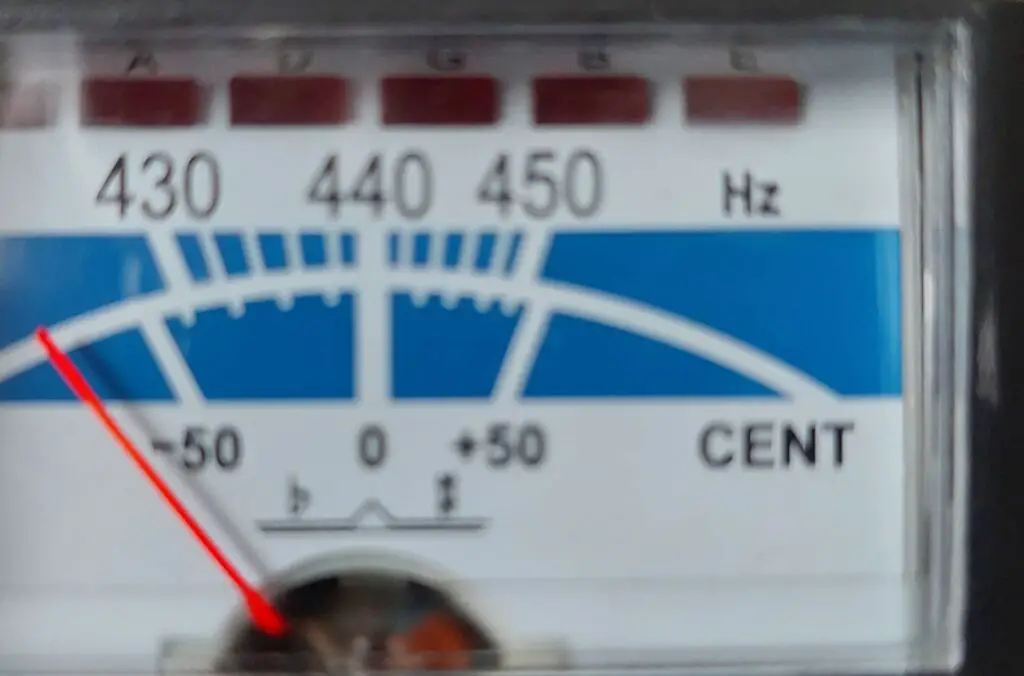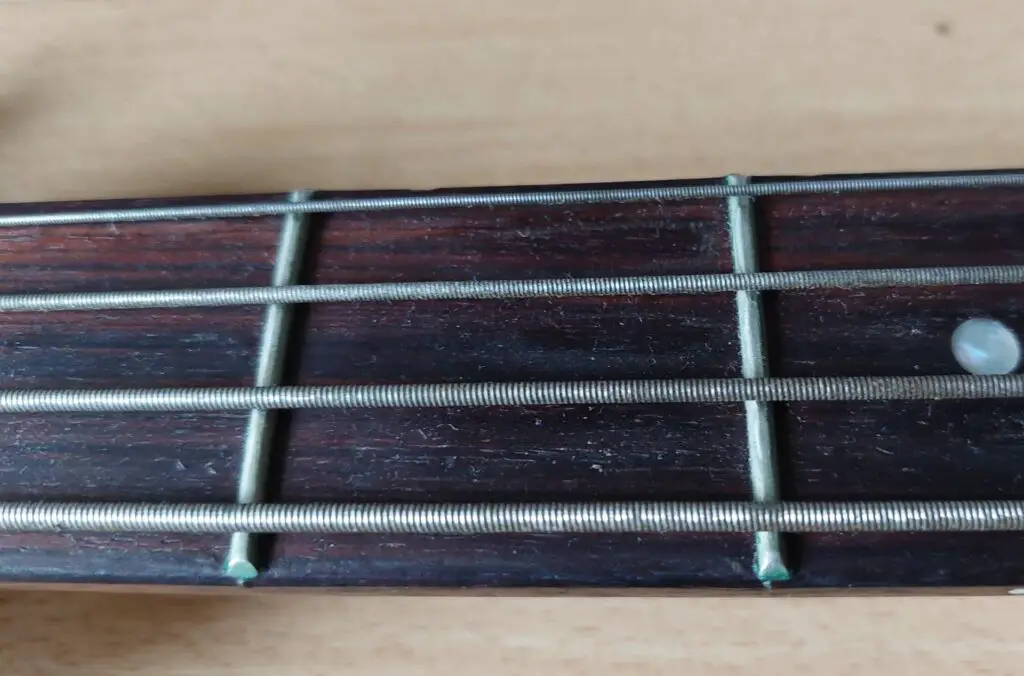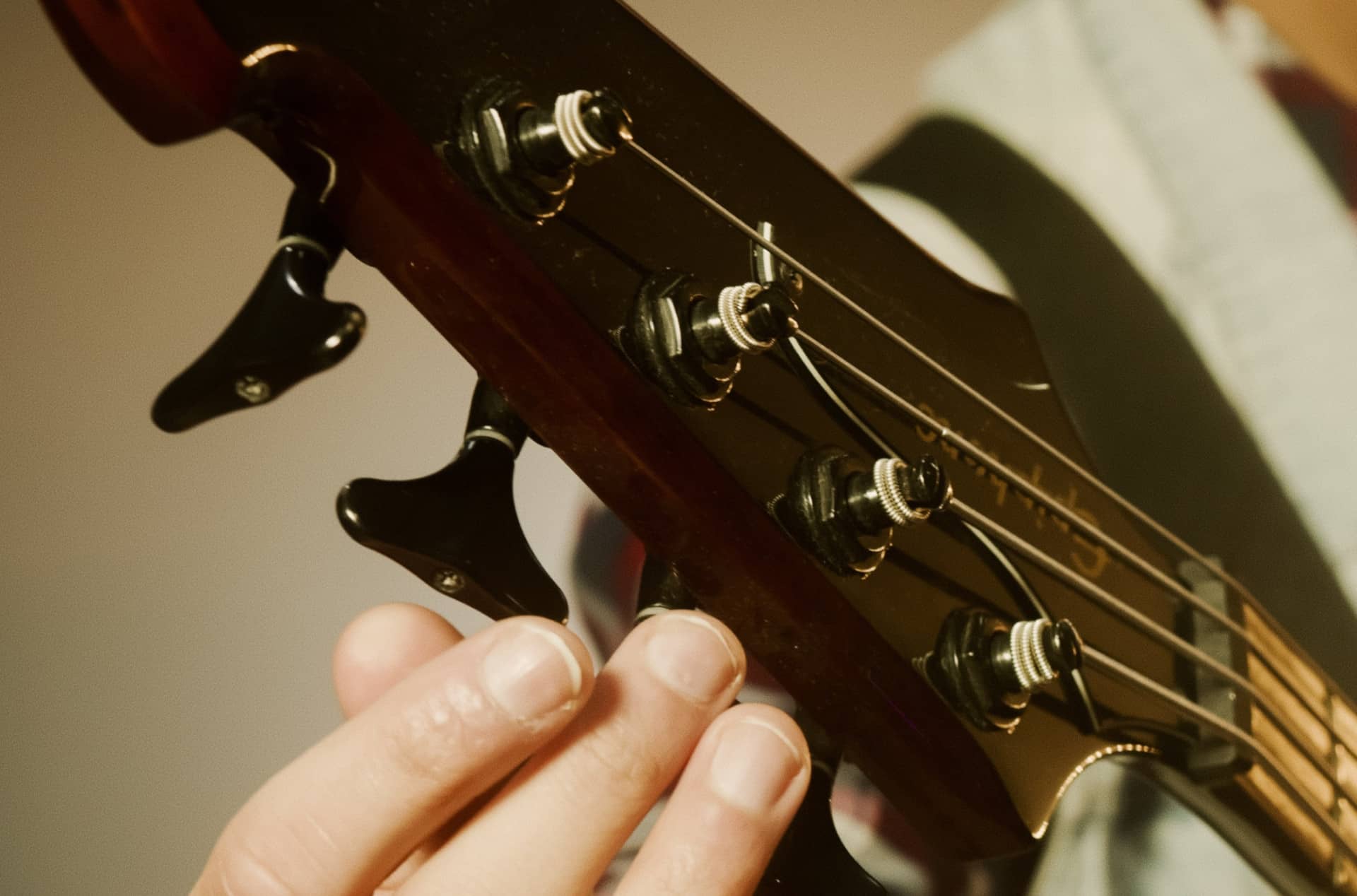Sometimes, you just want your bass to sound as heavy as possible. There are many ways to achieve this, but the best place to start is to tune down your instrument. If you are looking to tune as deep as you possibly can, chances are that you will end up tuning your bass to A standard.
I`ve played in several metal bands, and have thus explored the majority of alternate bass tunings. A Standard was deeper than I ever needed, but I have given it a try and learned the pros and cons of it.
Mainly, I learned that tuning to A is far more complicated than just loosening your strings. Thus, I decided to write a full guide for how to approach A Standard as a bassist, and what you need to be mindful of when tuning to it.
After reading, you will know how to tune to A and how to set up your bass for it correctly. Then, I will showcase the difference between A standard and Drop A and why people chose A standard over other tunings. I’ve also included a recording of what happens when you tune to A without the proper setup, as well as a list of bands that play in A that you can check out.
What is A standard tuning on bass?
A Standard is a bass tuning where the strings are tuned perfect fourths apart, and the deepest string is tuned to A. On a 4-string bass, the strings are tuned to A-D-G-C in A standard. 5-string basses in A standard are tuned to A-D-G-C-F.
The intervals between strings are the same in all standard tunings. Thus, if you play a riff written for E standard, you can also play it the same way in A standard. The difference will be that it will be in a different key, and a perfect fifth deeper.
Therefore, A Standard is a great option for achieving a deep and heavy sound, without having to utilize a drop tuning. This is because If you are familiar with playing in E standard, your knowledge of the fretboard can be applied the same way in A.
Here are some of the main reasons bands elect to use A standard over other tunings:
- Heavy sound – The majority of bands that use A standard play heavy and extreme sub-genres of metal. Death metal, deathcore and hardcore bands often use A standard to achive a brutal sound. The tuning is also used by heavy and symphonic metal acts for a more comercially accesible sound, while still sounding heavier than other bands within their genre.
- Pushing the limit – While you can keep tuning the bass deeper and deeper, there will come a point when you run into issues. Most noteworhty: Finding heavy enough strings, avoiding fret buzz, and retaining the playability of your isntrument. A Standard poses some challenges of its own, and tuning to G# is all the more challenging. Thus, A Standard is a natural tuning to land on for a bands that want to tune as deep as possible. Going any deeper is often not worth the hassle.
- 5 String basses and 7 string guitars – The deepest string on both 5 string basses and 7 string guitars is commonly tuned to B. These instruments are thus easier to tune down to A, than 4-string basses and 6-string guitars. Therefore, when B Standard isnt deep enough, A standard is the next logical step for 5-string players.

How do I tune my bass to A?
In order to tune a 4-string bass to A standard, tune every string a perfect fifth down from E standard to A-D-C-G. On a 5-string bass, tune every string 1 whole step down from B standard to A-D-C-G-C. You can do this by ear using a piano, or with a physical or an online tuner.
When it comes to deep tunings like A Standard, I recommend using a physical, chromatic tuner that you can plug your bass into. This is because it can be difficult for microphone-based tuners to properly pick up lower frequencies.
I recommend this tuner from KLIQ (click to see current prices on Amazon), as you can use it to tune both basses and guitars to any alternate tuning.
You can also use a piano or any instrument with a deep range to tune the bass by ear. The low A can be a little challenging if you are doing this for the first time. It is possible to hear the pitch, but you might find yourself “feeling” the note, rather than hearing it. This is perfectly fine, and it is normal to perceive deep frequencies this way.
Alternatively, you can use an online tuner with a microphone, such as this one. Depending on your mic, it might struggle to pick up the low A properly. If this happens, you can fret the deepest string at the 12th fret, and tune it to A.
Regardless of how you tune your bass, there are some things you should be mindful of in A standard:
- Strings – When tuning down a 4-string bass to A, you will need a set of heavier strings. Otherwise, the strings will be wobbly, feel dificilut to play, and produce a clanky sound. A 5-string bass can be played in A without changing your strings, but you will get a more powerful sound by switching to heavier gauge strings. I go more in depth about string chocie later in the article.
- Nut – The nut on a 4-string bass, will have to be filed down to acomodate the heavier set of strings. If not, the strings will not fit into the nut slots and your instrument will barley be playable. You can file the nut slots yourself gradually til the new strings fit into them. If you are not comfortable doing this, you can bring your bass into a shop that is familair with guitar and bass maintenence.
- Action– When you tune down you loosen the tension of your strings. As a result, the action of your strings will increase. This will make it more demanding to fret strings and make it harder to play fast. This can be partly mitigated by choosing a fitting set of heavy strings for A, and with a truss rod adjustment.
- Staying in tune – When you switch to a new tuning, it will take some time before your bass adjusts to it. Because of this, your bass will go out of tune significantly quicker after you tune down to A. Thus, be ready to tune your bass more freqcuently for a while. The longer the bass is tuned to A standard, the less frequecntly you will need to retune it.
What bands use A standard tuning?
A Standard is mainly utilized in heavier sub-genres of metal, by bands such as Mortician and Abiotic. The tuning has also seen some more commercial usage by bands such as Korn and Paradise Lost.
When a band tunes to A standard, they generally want to sound as heavy as possible. For some bands, the lower tuning helps them achieve a brutal deathcore sound. Others use it to play garden variety heavy metal, but heavier. Some bands utilize it to add a unique type of ambiance and heaviness to drone music.
Below is a table of 10 bands and bassists that have used A standard in various ways, and some examples of songs that they have done so on.
And look, I know the genre of some of these bands is hard to pin down. I’ve used my knowledge of the bands and the statement of others to give a broad definition of what type of music they play. I`m not making any statements about what elements constitute specific sub-genres. Cool? Cool.
| Band | Bassist | Genre | Songs in A Standard |
| Ektomorf | Csaba Farkas (1994-2008), Szabolcs Murvai (2008 and onward) | Groove Metal / Hardcore | “Last Fight”, “The One” |
| Korn | Fieldy | Heavy Metal / Alternative Metal | “Alone I Break”, “Blind”, “Falling Away From Me” |
| Hypocrisy | Mikael Hedlund | Death Metal | “A Thousand Lies”, “Inferior Devoties” |
| Jesu | Diarmuid Dalton (til 2007) | Experimental / Shoegaze | “Old Year”, “Silver”, “Dethroned” |
| Paradise Lost | Stephen Edmondson | Gothic Metal | “Beneath Broken Earth”, “Crucify”, “Fall From Grace” |
| Mortician | Will Rahmer | Deathgrind | “Blown To Pieces”, “Fleshripper”, “Rabid” |
| Dystopia | Todd Kiessling | Crust Punk | “Backstabber”, “Taste Your Own Medicine”, “Number One Hypocrite” |
| Obscura | Jeroen Paul Thesseling (2007-2011, and 2020 onward) Linus Klausenitzer (2011-2020) | Technical Death Metal | “Akróasis”, “Diluvium”, “Mortification Of The Vulgar Sun” |
| Myrath | Anis Jouini (2006 onward) | Progressive Metal | “Apostrophe For A Legend”, “Forever And A Day” |
| Abiotic | Killan Duarte (2018 onward), Alex Vasquez (2010–2016) | Deathcore | “The Absence Of Purity”, “Vermosapien”, “A Universal Plague” |

A standard tuning for 5-string basses
In order to tune a 5-string bass to A Standard, tune the strings to A-D-G-C-F. If the bass has an additional high string rather than a low one, the bass should still be tuned A-D-G-C-F, which will require a switch to heavier strings.
Setting a 5-string bass up for A standard is significantly easier than setting a 4-string up for it. This is because A standard is just 1 whole step away from B standard, which is the most common tuning for 5-string basses. This is similar to tuning to D standard on a 4-string bass.
Depending on the string gauges on the 5-string, you can get away with tuning to A standard without a string change. With a set such as .045-.065-.085-.105.-135, your strings will be on the lighter side for A, but it will sound alright.
Lighter gauges than this will be harder to play and sound thinner. Thus, getting a heavier set of strings, or at least a heavier deep string (.140-.160) for the low A will greatly improve the sound and playability of your bass.
A standard vs drop A tuning for bass
In A Standard, every string is tuned down a perfect fifth from E standard (ADGC). In Drop A, only the deepest string is tuned a perfect fifth down, while the rest of the strings are tuned down a perfect fourth (AEAD).
Drop A is thus A-E-A-D for a 4-string bass and A-E-A-D-G for a 5-string bass. It is effectively the same as B Standard, with the deepest string tuned a whole step.
Drop A has the same deep range as A standard, but it has 1 whole step more high range. This difference is largely insignificant.
Rather, the reason for choosing one of the tunings over the other largely comes down to what types of riffs your band is looking to play. For guitar players, Drop A allows for playing power chords with 1 finger rather than 2. Thus, for bands that utilize power chords at fast tempos, Drop A is often preferable to A Standard.
It is possible to play in A standard as a bassist, with guitarists that play in Drop A. However, this poses some challenges. Riffs that are written for one of the tunings can be difficult to play in the other, as they will require different fretting patterns. Furthermore, without a sound understanding of music theory, it can be time-consuming to share riffs and ideas between the bass and guitars when you are playing in different tunings.
The advantage of A Standard over Drop A is that the tuning makes it easier to play scales and chords. Thus, If you are familiar with playing in E standard, all of your knowledge of the fretboard will also carry over. Drop A makes scales less intuitive and will require you to recalibrate how you think about the fretboard.
The standard tuning of strings being a perfect 4th apart has become commonplace for a reason. Thus, unless drop A is necessary for playing certain riffs, or for the guitarists to quickly play power chords, A standard is generally the preferable tuning.

What bass strings should I use for A standard?
For A Standard, a balanced and fitting set of string gauges is .075-.095-.115-.145. . Depending on the tone you are looking for, these gauges can be slightly adjusted. For the low A string, you can elect to use an even heavier string in the .150-.160 range for a heavier tone.
Without heavy enough strings in A standard, your bass will sound clanky and lifeless. This will hold especially true for the deep A string.
As an example, here is an example of me playing on the D string in a bass in standard tuning (EADG). It`s a .065 string nickel wound that is a fitting gauge in this case:
The next example, is me tuning down to A standard with a regular set of strings meant for E. Specifically, I am playing on the second deepest string (regularly A, but now D, .085).
This is what happens when you tune a string a perfect fifth down when it isn’t built for it. Both sound examples are played with little, and equal accenting. Notice how the tone sounds powerless and the strings become more clanky:
This challenge will be the most noticeable when dealing with the deepest string on your bass. While A is only one whole step lower than B, it will still require a noticeably heavier string to get proper sustain and tone out of the low A.
5-string basses often have a .135 string for the low B, and I`ve seen some recommend this gauge for A standard. While a .135 generally sounds good when tuned to B, a string in the .145-.160 range is more suitable.
Playability, action, and fret buzz can all become issues if you go for too light of a string. Thus, if you are tuning down to A to sound heavier and more powerful, I advise getting at least a .145 gauge string for the lowest string.
Conclusion
If you want to go as low as possible, A standard is about as deep as it gets. Bands have used lower tunings such as G# and G, but these are really pushing the limits. Therefore, A Standard is a great tuning for bassists who want to sound extremely heavy, while maintaining the playability of their instrument.
It’s significantly easier to tune a 5-string to A than a 4-string. A 5-string will benefit from switching to heavier strings, while a 4-string will require it.
It is also important to be mindful of how you set up the bass when tuning down. You can file the nut and adjust the tension of the neck yourself. Alternatively, if you are uncomfortable with this you can get a bass tech to do this at a shop.
Setting your bass up for A standard also offers you a lot of flexibility. You will have access to the same deep range as the vast majority of tunings. As long as you are not playing riffs that heavily rely on an open string, you can play songs that are written for other tunings such as Drop C#, or D standard in A standard as well.
If you are looking to tune to A standard to sound heavy, it is a good idea to explore other alternative tunings first. For many bands, tuning down to C standard or Drop C is more than sufficient, and I recommend trying these tunings out before committing to A standard. To learn more about C Standard, read my complete guide to the tuning here.

